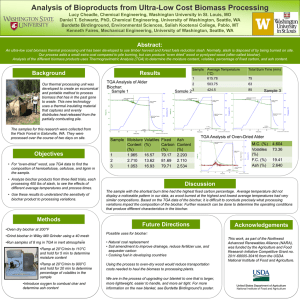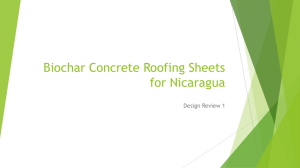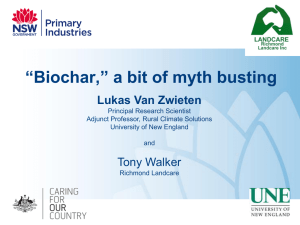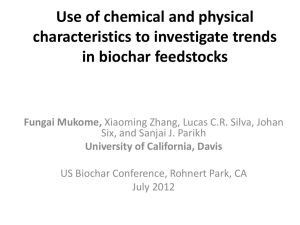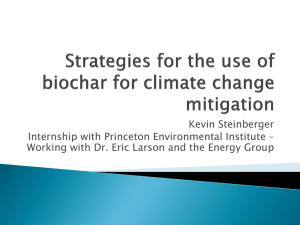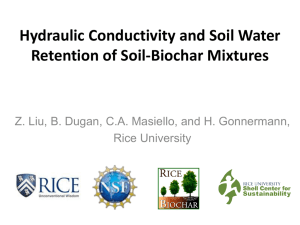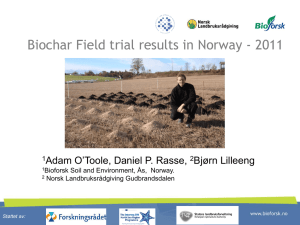Capturing Heat from a Small Biochar Production System
advertisement
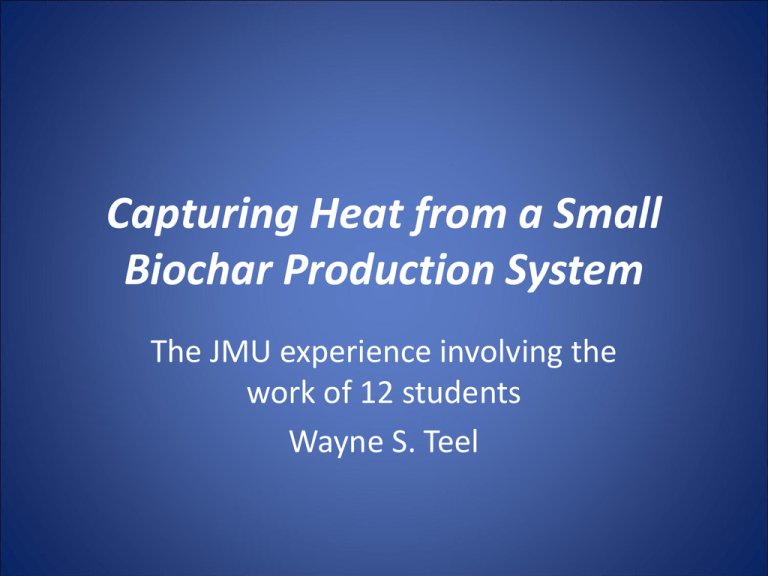
Capturing Heat from a Small Biochar Production System The JMU experience involving the work of 12 students Wayne S. Teel Humble Beginnings Upgrading the system Above: A 215 liter barrel with bolted lid and gas pipe. Left: The pyrolysis unit with a 500 liter water tank on top. Burn data from system II Data from six burns Burn date Wood Type Pyrolyzed wood, starting kg Biochar produced kg. % biochar Wood used for fuel - kg Highest production temperature1 1 Jan 29, 2011 Yellow pine 20.41 6.35 31% NA 560˚C 2 Feb 5, 2011 Black walnut 24.33 NA NA 40.9 430˚C 3 Feb 12, 2011 4 Feb 13, 2011 5 Feb 19, 2011 6 Mar 19, 2011 7 Mar 26, 2011 Miscanthus 7.36 2.4 33% 30.83 465˚C Red Cedar 12.16 4.5 37% 25.9 460˚C Bamboo 11.9 3.75 32% 29.85 480˚C Yellow Pine 34.8 7.9 23% 37.65 520˚C Yellow Pine 54.5 12.7 23% 46.5 520˚C 1Highest temperature reached inside the barrel during the burn. Energy data from 6 burns Burn # Total wood Kg1 Total wood energy – MJ2 Tank temp start - ˚C Tank temp End - ˚C Total energy Capture - MJ % energy capture water only3 2 65.23 832 6.7 42.5 74.9 9.0 3 38.19 487 2.0 31.6 61.9 12.7 4 38.02 485 13.2 39.4 54.8 11.3 5 41.75 532 13.9 44.7 64.4 12.1 6 72.45 956 13.6 70.3 119 12.4 7 101.0 1330 11.5 90.3 165 12.4 1Burns 6 and 7 used yellow pine exclusively. Burns 2-5 used a mix of woods for fuel and the material for pyrolysis is found in Table 1 above. 2Estimated water content for most wood is 15%. This amount was subtracted from the wood weight before doing the calculation. For yellow pine we experimentally determined the kiln-dried moisture content at 12% 3 The fire brick has a specific heat of 0.2 cal/gram ˚C, capturing approximately 84 MJ each burn. Avalon Acres Farm System On the left is the production unit with the heavy piano hinged door open to show the firebrick insulation and the pyrolysis barrel inside. Note also the 12 cm high water tank that makes up the roof of the burn chamber. On the right is the back of the unit next to the house where the send and return pipes are seen. These are protected from the heat with reflective aluminum insulating tape. Temperature data Temperature data from the March 13, 2012 burn. Note the highest inner chamber temperature is well above the range recommended by Lehmann et al. 2003. Burns at Avalon Acres Burn date Wood Type Pyrolyzed Biochar % Wood used Highest wood, produced biochar for fuel - kg production starting kg kg. temperature1 1 Jan 14, 2012 Local mix2 31.72 5.62 18% 47.49 NA 2 Jan 24, 2012 Local mix 31.43 8.17 26% 51.6 840˚C 3 Feb 25, 2012 Feb 28, 2012 Mar 13, 2012 Mar 18, 2012 Mar 27, 2012 Apr 1, 2012 Local mix 22.08 5.84 26% 78.34 NA Local mix 15.97 4.17 26% 59.06 710˚C Local mix 24.16 5.41 22% 51.46 670˚C Local mix 21.64 4.28 20% 43.36 NA Local mix 19.21 4.42 23% 60.24 690˚C Local mix 18.39 4.28 23% 42.47 650˚C 4 5 6 7 8 1Highest temperature reached inside the barrel during the burn. Bichar post burn and crushed On the left is eastern red cedar biochar and on the right is the ground up biochar before mixing with manure and compost. Raised beds with biochar/compost On the left is a new lettuce bed enhanced with a biochar and compost mix. On the right is a bed of Swiss chard also using the biochar compost mix. Characteristics of biochar Average % ash content Wood type Production Temperature °C pH Density (g/cm3) Bone1 -- 10.90 0.82 90.9 Poultry1 8.86 8.14 0.77 64.9 Pine (2010) 1 --- 0.27 1.06 Black Walnut1 430 6.63 0.30 0.77 Bamboo1 465 7.51 0.32 6.06 Pine (2011) 1 5.60 7.62 0.30 1.80 Cedar1 560 460 3.06 Cedar2 600 9.68 0.33 0.25 630 7.87 0.27 Sycamore2 1Data from Becker, 2011 2Data from Decker, Martindale, Najamy-Winnick, Spolarics. 2012 2.00 2.39 Scanning Electron Images of Cedar biochar Comparison of cedar biochars made in 2011 and in 2012. In the 2011 burn the maximum temperature in the inner chamber reached 460⁰C and the pore walls were about 1.6 microns thick. In the 2012 burn the maximum temperature in the inner chamber reached 590⁰C and the pore walls were about 1.4 microns thick. Total Gravimetric Analysis in a nitrogen gas atmosphere Total Gravimetric Analysis of cedar biochar under a nitrogen atmosphere showing the loss of volatiles between room temperature and 700˚C TGA in an oxygen atmosphere Shows the cedar biochar in oxygen rich environment during TGA run on 03/16/12. Plans and Improvement • Design, construction and testing of new units on three farms • Improvement of the door • Cladding for hoop house designs • Insulation for Avalon Acres Farm • Characterization work using TGA and SEM • Nine students are involved in the 2012-13 academic year
